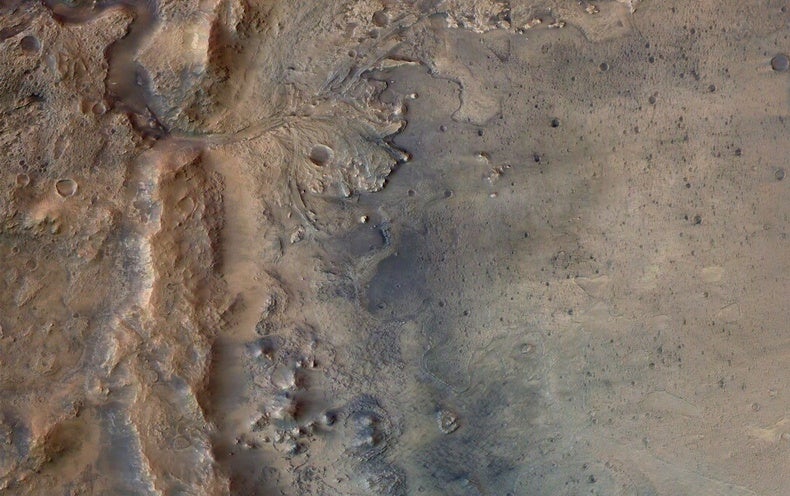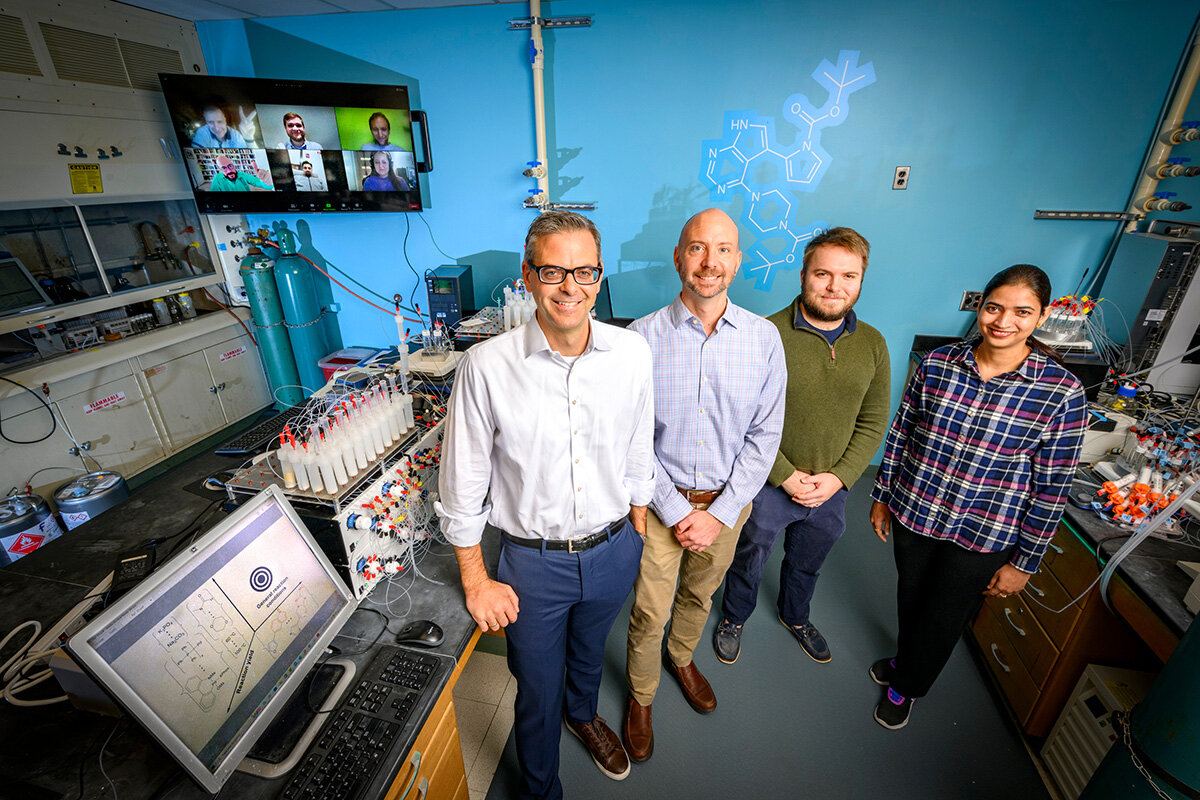Although we know that early Mars was wetter, warmer and more habitable than today’s frozen desert world, researchers have yet to find direct evidence that life of any kind ever graced the Martian surface. If Mars was once home to life, key questions remain: How did such life affect the planet, and where can we find evidence of its past existence? A new study addressing these mysteries counterintuitively finds that a plausible Martian biosphere may have been instrumental in tipping the planet into its current inhospitable state. The findings further suggest that certain regions of Mars — including Jezero Crater, where NASA’s Perseverance rover is now roaming — are the best places on the planet to look for signs of life. And they ominously hint that life may be the greatest enemy of worlds in the entire cosmos.
Using climate and terrain models to recreate Mars as it was four billion years ago, French researchers have concluded that microbes may once have thrived just centimeters below most of the Red Planet’s surface, protected by the raw cosmic radiation from the overlying soil. But this buried biosphere would eventually have retreated deeper into the planet, perhaps to its demise driven by the cold temperatures it created. The study, published in natural astronomy, suggests that these hypothetical ancient microbes absorb hydrogen and carbon dioxide from the Martian atmosphere and in turn produces methane. All three substances can act as heat-trapping greenhouse gases, meaning that changes in the abundance of each can have a significant impact on the planet’s surface temperature. In this case, the net decrease in atmospheric greenhouse gases from this putative “methanogen” biosphere would have caused a global cooling that covered most of the surface of Mars in ice, helping to create the planet’s inhospitable and barren current state.
“Basically what we’re saying is that life, when it appears on the planet and in the right state, can self-destruct,” said Boris Soteri, a postdoctoral fellow at the Sorbonne University in Paris and lead author of the report. “It is this self-destructive tendency that may limit the ability of life to emerge widely in the universe.”
Gaia’s Blessings—or Medea’s Curse?
In 1965, the late chemist James Lovelock — then a researcher at NASA’s Jet Propulsion Laboratory — came up with a feasible strategy for discovering life on other worlds. Lovelock and his fellow researchers argue that certain chemical compounds in the planet’s atmosphere act as so-called biosignatures, indicating the global presence of life. On Earth, for example, the coexistence of methane (from methanogens) with oxygen (from photosynthetic organisms) constitutes a powerful biosignature: each gas destroys the other under environmental conditions, so the persistence of both indicates steady replenishment, which is most easily explained with biological sources. Lovelock’s work formed the basis for the scientific search for extraterrestrial life on other worlds that continues today.
The idea that life intimately influences Earth’s atmospheric chemistry became the basis of what Lovelock called his Gaia hypothesis, which he would go on to refine with microbiologist Lynn Margulies in the 1970s. The Gaia hypothesis, named after the “Mother Earth” deity of Greek mythology, posits the idea that life is self-regulating. Organisms on Earth collectively interact with their surroundings in such a way that the habitability of their environment—in this case, the planet itself—is maintained. For example, higher global temperatures from excess atmospheric carbon dioxide can also stimulate plant growth, which in turn can drain more of the greenhouse gas from the air, ultimately returning the planet to a cooler state.
In 2009, paleontologist Peter Ward of the University of Washington took a less optimistic view. On a planetary scale, Ward argues, life is more self-destructive than to self-regulate and eventually erase itself. In opposition to the Gaia hypothesis, he named his idea after another figure from Greek mythology: Medea, a mother who kills her own children. To support his “The Medea Hypothesis,” Ward cites several mass extinction events from Earth’s history that may indicate the inherently suicidal nature of life. During the Great Oxidation Event more than two billion years ago, photosynthetic cyanobacteria pumped massive amounts of oxygen into Earth’s atmosphere, which until then had been nearly devoid of the highly reactive gas. This inevitably led to the destruction of the previous masters of the planet – the methanogens and other “anoxic” organisms for which oxygen was toxic. “You just look back at Earth’s history and you see periods where life was its own worst enemy,” says Ward, commenting on the apparent connection between his Medea hypothesis and Soteri and his colleagues’ research. “And I think that certainly may have been the case on Mars.”
In a decidedly gay twist, this catastrophic event for Earth’s anoxic life was also a catalyst that allowed other organisms to flourish: the flood of atmospheric oxygen proved crucial to the biological diversification of our planet and the eventual emergence of the multicellular ancestors of our modern biosphere. Therefore, understanding whether life is ultimately gay or midian may be a matter of perspective, requiring a more expansive—and interplanetary—perspective. But until life is discovered and studied on other worlds, only speculative comparisons can be made through theoretical studies like Sauterey’s.
A deeper look at Martian life
Kave Pakhlevan, a researcher at the SETI Institute, says the study, which he was not involved in, “expands the way we think about the effects that biospheres can have on habitability.” But he also says the study only looked at the planet-changing effects of one type of metabolism. For example, it will fail to capture the complexity of something like the Great Oxidation Event, which depends on the conflicting influences of methanogens and cyanobacteria. Sauterey acknowledges this potential drawback: “You can imagine that a more complex, more diverse biosphere [on Mars] it wouldn’t have the negative effect on the habitability of the planet that methanogens alone would have,” he says.
Yet this limitation of the study’s conclusions may itself be diagnostic of a more fundamental truth. Early Earth’s abundance of diverse microbial life—and the resulting evolutionary flexibility to recover from otherwise catastrophic environmental changes—may be why Earth’s complex biosphere endured while a supposedly simpler one on Mars simply disappeared. According to Ward, the ascent to ever-greater complexity may help the biosphere avoid an otherwise bleak mussel fate. “I really believe that the only way out—the only way for any planet to escape once it gets life—is to develop intelligence,” he says. Only then, says Ward, could technological solutions emerge to mitigate the tendencies of Mussel life to pollute its planetary nest.
The study did not address the possibility that modern methanogens lurk in the Martian subsurface. Such a situation could help explain the enigmatic plumes of methane that scientists have repeatedly detected in the planet’s atmosphere (although lifeless geophysical activity could also explain the plumes).
For an ancient Mars, however, the study points to places on the planet where theorized microbes could have thrived closer to the surface (and therefore within reach of today’s fossil studies). Such hotspots equate to rare regions of Mars that could have remained ice-free for large stretches of the planet’s subsequent history despite near-global glaciation from global cooling. Jezero Crater—the site of an ancient lake and a vast sedimentary delta that may preserve fossils—is one such place. Coincidentally, this is also where NASA’s Perseverance rover is now working to retrieve potentially biosignature-bearing materials for subsequent analysis in laboratories on Earth. But whether fossil evidence for early methanogens would be available there is unclear. They may be buried under deep layers of sediment, beyond Perseverance’s reach.
Beyond the Jezero crater, the study found two even more promising sites for potential near-surface evidence of past methanogens: the Hellas Planitia and Isidis Planitia regions of Mars. This plethora of possible targets is part of a broader trend of growing interest in the Martian subsurface that could lead to investigations more focused on looking for signs of life there, said Victoria Orphan, a geobiologist at the Caltech Institute who did not participated in the study. Sauterey’s study, she says, is “a starting point to help stimulate debate and deeper thinking about future missions.”
“But of course this is all super hypothetical and so it’s complicated,” Soteri says. “All we can say is that the crust was habitable with that probability, in the given location on Mars.” Sauterey is careful to note that just because Mars was once habitable, that doesn’t mean the planet was ever inhabited.
Whether or not ancient methanogens once lived on Mars, the results of the new study are a reminder of how life itself can create the conditions for its own flourishing — or extinction — on any world in the cosmos. Even single-celled organisms have the power to transform an otherwise habitable planet into a hostile place. And Soteri darkly adds, “with the technological means at our disposal, people can do this even faster.”
https://www.scientificamerican.com/article/life-on-mars-may-have-been-its-own-worst-enemy/










